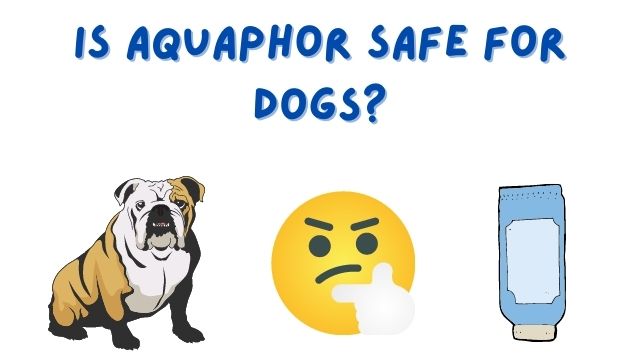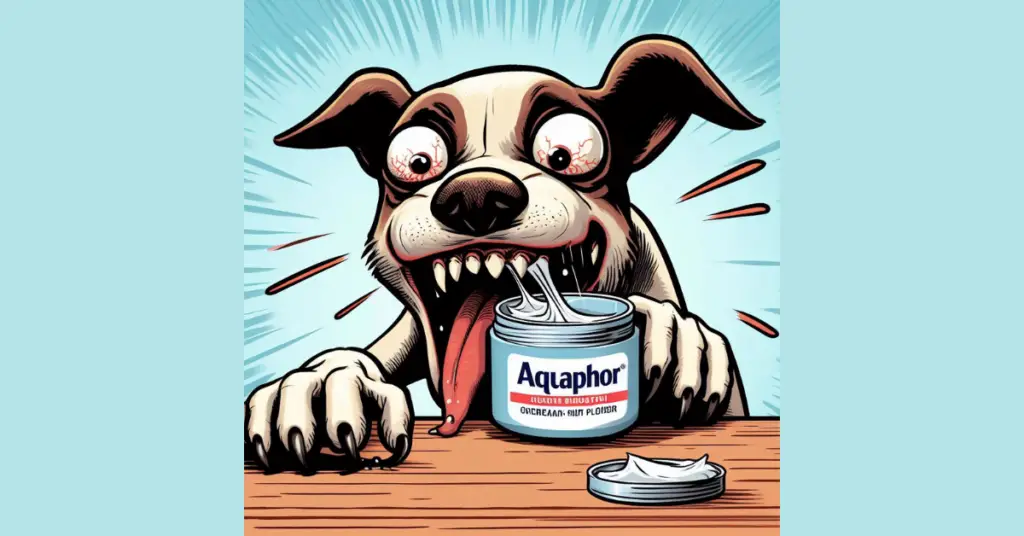Aquaphor is a well-known ointment with proven health benefits for people. But what about dogs? Is Aquaphor safe for dogs?
Yes, Aquaphor is safe for dogs. Although being formulated for humans, Aquaphor is safe for use on dogs as well. If your dog ate, Aquaphor know that it is not toxic to dogs, but it may upset their digestive system resulting in vomiting and diarrhea.
In this article, we’ll answer any questions on whether Aquaphor is safe for dogs. Including if it is toxic for dogs to eat, how to safely apply aquaphor for dog health, and some other common questions!

Dog Ate Aquaphor: Is It Toxic?
Ingesting some aquaphor will not be toxic to your dog. However, that does not mean it is safe for eating. Namely, if your dog licks Aquaphor after application or decides to get into the jar and eat directly from the source, the worst thing that can happen is digestive upset.
Aquaphor acts as a lubricant and will upset the dog’s stomach and intestines causing an episode of diarrhea, vomiting, loss of appetite, abdominal pain, dehydration, and lethargy.
The severity of the digestive upset depends on several factors such as the amount of Aquaphor consumed, the dog’s age, weight, and overall health. The upset may be more pronounced in dogs allergic or sensitive to lanoline as this is one of Aquaphor’s ingredients.

Can You Put Aquaphor on Dog Skin?
Yes, you can definitely put Aquaphor on a dog’s dry skin. In fact, moisturizing is one of the main effects of Aquaphor. Most vets recommend applying a thin layer of Aquaphor over dry body areas twice per day. Again, this product is entirely safe for use on your dog as a topical ointment!
Aquaphor is powerful in combating dry skin, and there will be visible improvements and decreased dryness after a couple of uses. Because of its non-toxic and benign nature, both Aquaphor and Vaseline, which is another petroleum jelly, are safe for pets. Aquaphor can also be used in conjunction with other dry skin treatments such as coconut oil and oatmeal baths.
Safely Putting Aquaphor On Your Dog
There are several approved and beneficial uses of Aquaphor for dogs. However, we should note that it is always a good idea to consult with your vet before using a home remedy on your dog. With that being said, Aquaphor is considered sufficiently safe so here are some of the most common uses of Aquaphor with you pet.
Use number 1: Dry nose
Some dogs have more moisturized noses than others naturally. Environmental factors such as heat and humidity affect nose dryness as well. Dogs experiencing dry noses can benefit from Aquaphor applications. A dry nose is not dangerous, but it can be uncomfortable.
Use number 2: Peeling paw pads
The dog’s paws are delicate and rather sensitive body parts. The skin can get easily damaged by walking on hot pavement, snow, or ice-melting chemicals. Taking proper care of the paws includes using protective ointments in order to ensure dog health. Aquaphor is the perfect example of such an ointment.
Use number 3: Scaly elbows
If you have ever had an issue with scaly elbows, you know what we are talking about. Scaly elbows are common in dogs, especially in larger breeds putting too much pressure on the elbows. In such cases, Aquaphor can be used to moisten the elbows and prevent painful scaling of the skin for your pet.
Use number 4: Minor cuts and burns
Another common use of Aquaphor is for minor cuts and burns. The ointment will keep the area moist and protected while allowing it to breathe – a factor important for preventing skin infections.
Use number 6: Skin irritation
Skin irritations are more than common in dogs. They can be caused mechanically or triggered by allergies. Regardless of the cause, applying Aquaphor over irritated skin is helpful. The natural anti-inflammatory features will help soothe the skin and provide much-needed relief for any pet.
Use number 7: Pet tattoos
Pet tattoos were a popular identification method in the past. Today, there are not so common but still an option. Aquaphor is the perfect ointment for tattoo aftercare. As mentioned, Aquaphor allows breathing while both soothing and protecting the area.
Is Aquaphor Safe To Use for A Dog’s Ears?
If you think about applying Aquaphor on the external parts of the ear, such as the ear flap, then the answer is yes, Aquaphor is safe. However, Aquaphor is not safe for internal use within the ear canals.
Aquaphor has a wax-like texture and will block the ear canals, thus only aggravating the ear conditions. So, to put things bluntly, Aquaphor can be used on the outside of the ears but not inside them.
If your dog has an ear problem, you need to check with your vet as soon as possible. Ear infections tend to worsen really quickly and are quite painful, thus requiring immediate veterinary attention.
Is Aquaphor Safe for A Dog’s Nose?
Yes, Aquaphor is safe for a dog’s nose. If your dog’s nose is dry and cracked, you can put a layer of Aquaphor several times a day until the condition resolves. Once the ointment is applied, you need to keep your dog busy and prevent it from licking.
Ingesting the applied amount of Aquaphor is not harmful as the ointment is not toxic to dogs. However, if licked before absorbed, it loses its efficacy, thus defeating the purpose of applying it in the first place.
Is Aquaphor Safe for Surgical Wounds?
The general rule of the thumb is not to put anything on surgical wounds, especially if the stitches are still on. In the past, there were recommendations about the use of antibiotics and different ointments.
Today, the practice is abandoned as the ointments may serve as breeding grounds for bacteria. So, to answer the main question – no, it is not safe to put Aquaphor on surgical wounds. The only exception to this rule is if the vet recommended the use.

What Do I Do if My Dog Is Eating Aquaphor?
If your dog is eating Aquaphor, you need to be prepared for digestive upset. Based on the mentioned factors and potential stomach upset intensity, it is possible to manage the situation at home. However, if things seem too severe, you should seek veterinary help.
Here are some helpful tips on what to do at home:
- Withhold food for a couple of hours – when a dog eats something inedible, withholding food is the first aid. This will prevent overburdening the stomach.
- Give bland diet – make a bland diet (mixture of plain boiled white rice and white chicken or turkey meat) and use it for a couple of days.
- Add probiotics – probiotics can do wonders when it comes to managing stomach upsets and diarrhea bouts. It is highly advisable to use a probiotic made exclusively for dogs.
- OTC medications – you can use Pepto Bismol to soothe your dog’s stomach and manage diarrhea. However, we should note that it is important to talk with the vet before giving your dog medication.
Summing Up: Aquaphor for Dogs
All in all, Aquaphor is safe for dogs. Using Aquaphor on your dog is efficient and beneficial in various situations. However, do not forget that Aquaphor is designed for external use – meaning you should keep your dog occupied and prevent licking.
In case of accidental Aquaphor ingestions, it is reasonable to expect a digestive upset. The good news is that Aquaphor is not toxic and cannot kill a dog. Still, digestive upsets are troublesome – uncomfortable and tedious.
If you are not sure whether your dog’s issue or condition can benefit from Aquaphor, it is highly advisable to consult with your vet. Also, make sure you call the vet if you have been using Aquaphor for several days and there is no visible improvement.

